Scabies on Wrists: Symptoms, Causes, and Treatment Guide
What are the common symptoms of scabies on wrists. How is scabies transmitted and diagnosed. What are the most effective treatments for scabies. How can you prevent scabies infestations.
Understanding Scabies: A Microscopic Menace
Scabies is a highly contagious skin condition caused by tiny mites known as Sarcoptes scabiei. These microscopic parasites burrow into the outer layer of skin, causing intense itching and a characteristic rash. While scabies can affect various parts of the body, it often manifests on the wrists, making it crucial to understand its symptoms, causes, and treatment options.
What exactly are scabies mites?
Sarcoptes scabiei are minuscule arachnids, barely visible to the naked eye. These parasites have a preference for warm areas of the body, such as skin folds and between fingers. Once they penetrate the skin, female mites lay eggs in the burrows they create, perpetuating the infestation cycle.
Recognizing Scabies Symptoms on Wrists
Scabies on wrists can be particularly troublesome due to the frequent movement and exposure of this area. Identifying the symptoms early is crucial for prompt treatment and preventing spread.

What are the telltale signs of scabies on wrists?
- Intense itching, especially at night
- Rash with small, red, raised bumps
- Thin, irregular burrow tracks on the skin
- Scaling or crusting of the affected area
- Tiny blisters or pustules
The wrist area is particularly susceptible due to its thin skin and frequent contact with other surfaces. Scabies mites often target the inner wrist and the spaces between fingers, making these areas hotspots for infestation.
The Scabies Transmission Puzzle
Understanding how scabies spreads is crucial for both prevention and containment of outbreaks. Contrary to popular belief, scabies is not a result of poor hygiene but rather close physical contact with an infected individual.
How does scabies spread from person to person?
Scabies transmission primarily occurs through prolonged skin-to-skin contact with an infested person. This contact typically needs to be direct and last for at least 15-20 minutes. Common scenarios for transmission include:

- Sexual contact
- Sharing a bed or living space
- Close physical care of an infected person
- Crowded living conditions
It’s important to note that casual contact, such as handshakes or hugs, rarely results in transmission. However, individuals with crusted scabies, a severe form of the condition, are highly contagious and can spread the mites through brief skin contact or via infested bedding and furniture.
Diagnosing Scabies: Beyond the Itch
Accurate diagnosis of scabies is crucial for effective treatment. While the intense itching and characteristic rash are strong indicators, definitive diagnosis often requires a more thorough examination.
How do healthcare professionals diagnose scabies?
Diagnosing scabies typically involves a combination of clinical observation and microscopic examination. The process may include:
- Visual inspection of the affected areas, particularly the wrists and between fingers
- Use of a dermoscope to identify burrows and mites
- Skin scraping to examine under a microscope for mites, eggs, or fecal matter
- Ink test, where burrows are made visible by applying ink to the skin
In some cases, especially when symptoms are atypical, a skin biopsy may be necessary to confirm the diagnosis and rule out other skin conditions.
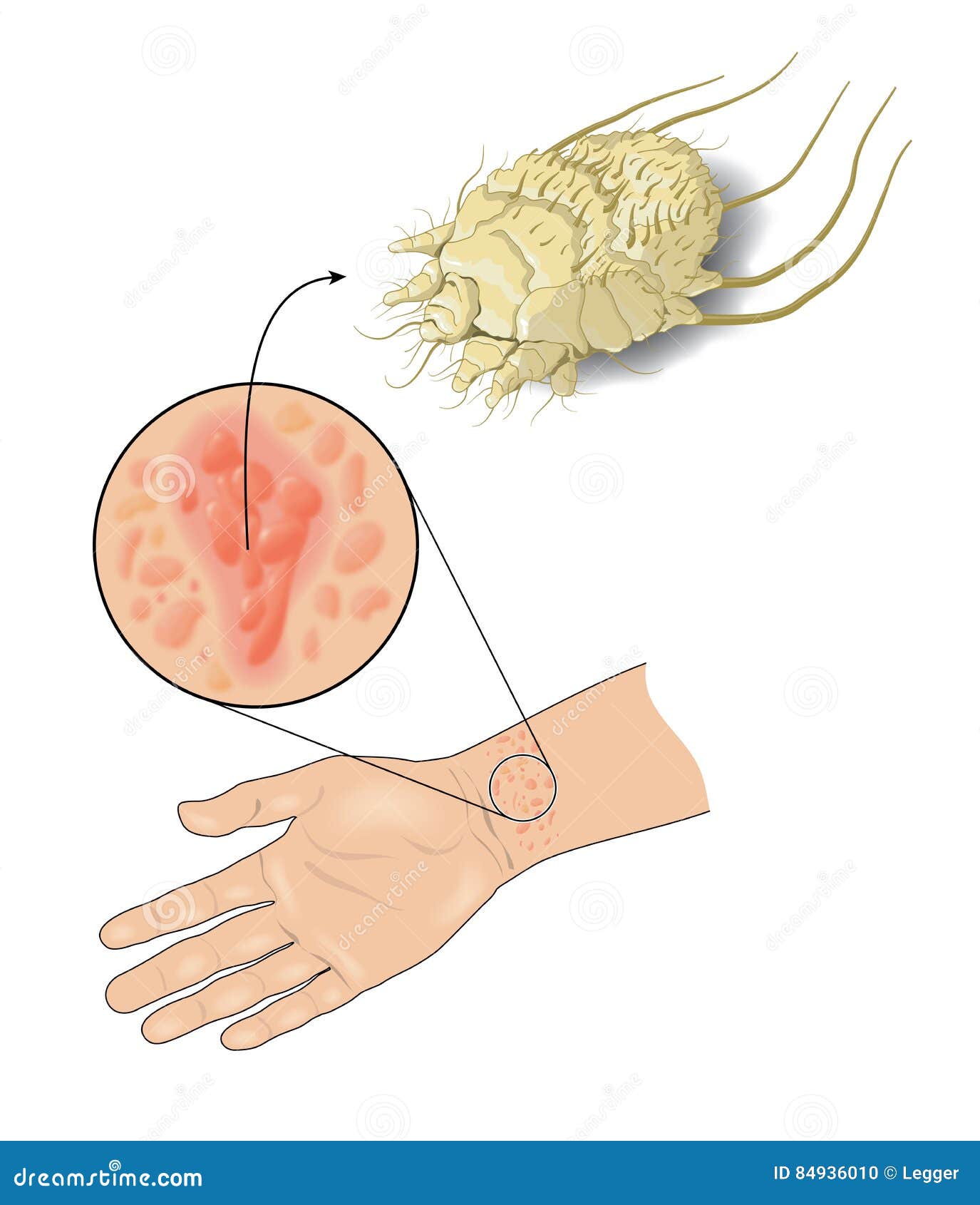
Effective Treatments for Scabies Infestations
Once diagnosed, scabies requires prompt and thorough treatment to eradicate the mites and alleviate symptoms. The primary goal is to eliminate the infestation and prevent reinfestation or spread to others.
What are the most effective treatments for scabies?
Treatment for scabies typically involves prescription medications, often in the form of topical creams or oral medications. Common treatments include:
- Permethrin cream 5%: Applied from neck to toes and left on for 8-14 hours before washing off
- Ivermectin: An oral medication, particularly effective for severe or resistant cases
- Crotamiton cream or lotion: Applied daily for 5 days
- Lindane lotion: Used in cases where other treatments have failed, but with caution due to potential toxicity
In addition to medication, treating all close contacts simultaneously is crucial to prevent reinfestation. This includes family members, sexual partners, and individuals sharing living spaces.

Post-Treatment Care and Symptom Management
After completing the prescribed treatment, it’s common for itching to persist for several weeks. This is often due to the body’s ongoing immune response rather than active infestation.
How can you manage post-treatment symptoms?
- Use antihistamines to reduce itching
- Apply calamine lotion to soothe irritated skin
- Take cool baths with colloidal oatmeal
- Moisturize the skin regularly
- Avoid scratching to prevent secondary infections
It’s important to follow up with a healthcare provider if symptoms persist or worsen after treatment, as this could indicate treatment failure or reinfestation.
Preventing Scabies: Breaking the Cycle
Prevention is key in controlling scabies outbreaks. While it’s not always possible to avoid exposure, certain measures can significantly reduce the risk of infestation.
What steps can be taken to prevent scabies infestations?
- Avoid skin-to-skin contact with individuals known to have scabies
- Wash and dry clothes, bedding, and towels used by infected persons on high heat
- Seal items that can’t be washed in plastic bags for at least 72 hours
- Vacuum carpets and upholstered furniture thoroughly
- Educate family members and close contacts about scabies transmission
In institutional settings like nursing homes or schools, implementing routine screening and prompt treatment of infected individuals is crucial to prevent widespread outbreaks.

Scabies in Special Populations: Unique Challenges
While scabies can affect anyone, certain populations face unique challenges in diagnosis, treatment, and prevention. Understanding these special cases is crucial for effective management.
How does scabies manifest differently in various populations?
Infants and young children: Scabies in this group often affects the head, face, neck, palms, and soles – areas typically spared in adults. The rash may appear more vesicular or pustular.
Elderly individuals: They may experience a more subtle presentation, with less itching due to decreased skin sensitivity. This can lead to delayed diagnosis and treatment.
Immunocompromised patients: These individuals are at risk for developing crusted (Norwegian) scabies, a severe form characterized by thick, scaly patches containing millions of mites. This form is highly contagious and challenging to treat.
Healthcare workers: They are at increased risk due to frequent close contact with potentially infected individuals. Strict adherence to infection control measures is crucial.

The Psychological Impact of Scabies
Beyond the physical symptoms, scabies can have significant psychological effects on those affected. The intense itching, visible rash, and social stigma associated with the condition can lead to various mental health challenges.
How does scabies affect mental health?
- Anxiety and stress due to persistent symptoms and fear of spreading the condition
- Sleep disturbances from intense nighttime itching
- Social isolation and embarrassment
- Depression, especially in cases of prolonged or recurrent infestations
- Phobias related to insects or parasites (entomophobia)
Addressing the psychological aspects of scabies is an important part of comprehensive care. Healthcare providers should be prepared to offer support or referrals for mental health services when needed.
Scabies Myths and Misconceptions
Despite being a well-documented condition, scabies is surrounded by numerous myths and misconceptions. Dispelling these can help reduce stigma and improve understanding of the condition.

What are some common myths about scabies?
- Myth: Scabies is caused by poor hygiene.
Reality: Scabies can affect anyone, regardless of cleanliness. - Myth: Scabies can jump or fly from person to person.
Reality: Scabies mites can only crawl and require prolonged skin-to-skin contact to spread. - Myth: You can get scabies from animals.
Reality: Human scabies is caused by a different species than animal scabies and doesn’t spread between humans and pets. - Myth: Once treated, you’re immune to future infestations.
Reality: You can get scabies multiple times; there’s no long-term immunity. - Myth: Over-the-counter treatments are effective for scabies.
Reality: Prescription medications are typically necessary for successful treatment.
Educating patients and the public about these misconceptions can help reduce the stigma associated with scabies and encourage prompt seeking of medical care when symptoms arise.
Global Perspective: Scabies as a Public Health Concern
While often viewed as a minor nuisance in developed countries, scabies poses a significant public health challenge globally, particularly in resource-limited settings.
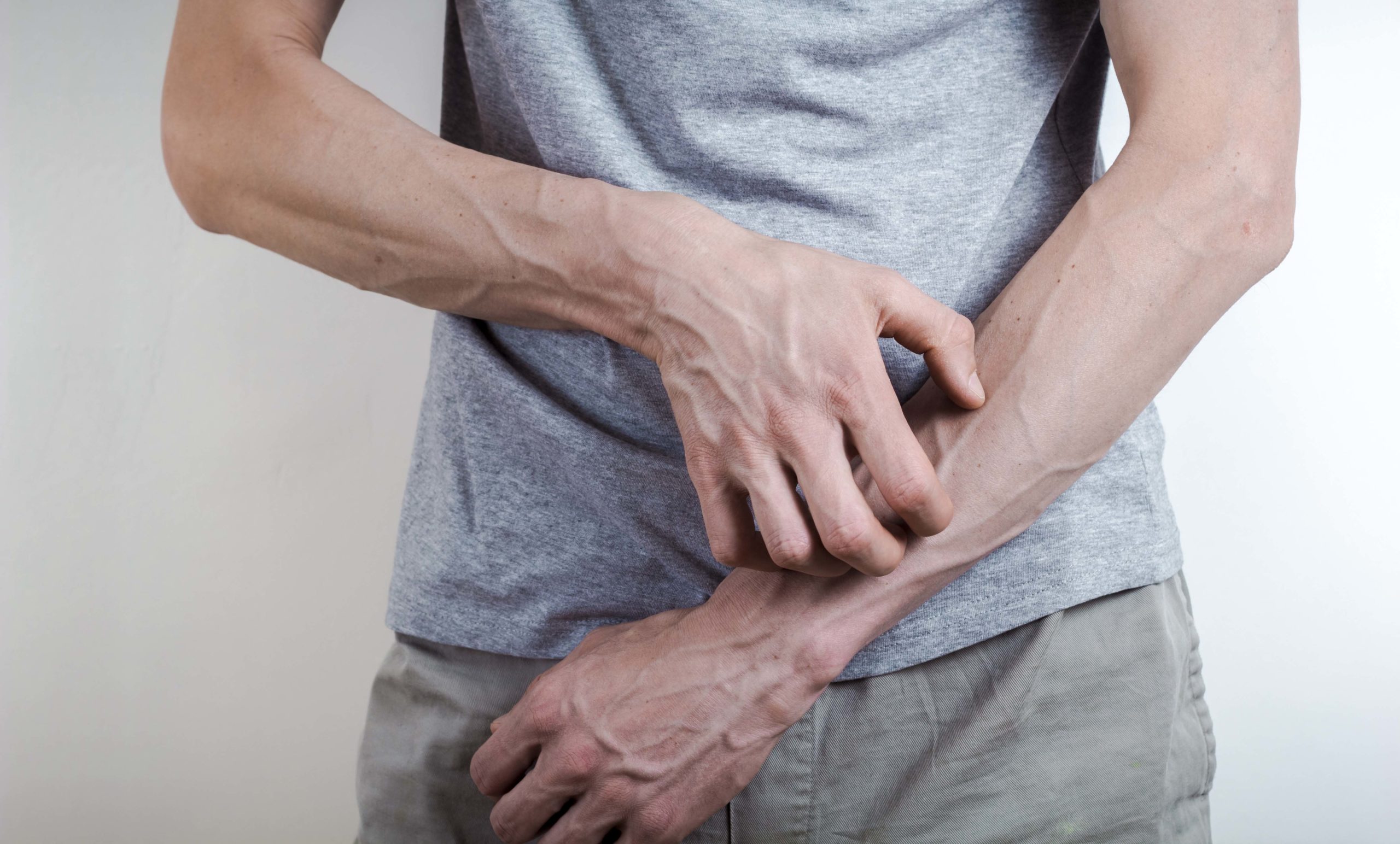
How does scabies impact global health?
Scabies affects millions of people worldwide, with higher prevalence in tropical and subtropical regions. The World Health Organization (WHO) has recognized scabies as a neglected tropical disease, highlighting its impact on public health and socioeconomic development.
- Prevalence: Estimates suggest over 200 million people are affected globally at any time.
- Economic burden: Scabies results in significant healthcare costs and lost productivity.
- Complications: In resource-limited settings, secondary bacterial infections from scabies can lead to serious complications, including sepsis and kidney disease.
- Community impact: Outbreaks in close-contact settings like schools or refugee camps can be challenging to control.
Efforts to combat scabies on a global scale include mass drug administration programs in endemic areas and improved access to diagnostic tools and treatments.
Future Directions in Scabies Research and Management
As our understanding of scabies evolves, researchers and healthcare professionals continue to explore new avenues for prevention, diagnosis, and treatment.

What are the emerging trends in scabies research?
- Vaccine development: Efforts are underway to develop a vaccine against scabies, which could revolutionize prevention strategies.
- Novel treatments: Research into new antiparasitic compounds and formulations aims to improve treatment efficacy and reduce side effects.
- Diagnostic advancements: Development of rapid, non-invasive diagnostic tools could improve early detection and treatment.
- Environmental control: Exploring methods to eliminate mites from the environment more effectively, reducing the risk of reinfestation.
- One Health approach: Integrating human, animal, and environmental health strategies to address scabies comprehensively.
These research directions hold promise for more effective management of scabies in the future, potentially reducing its global burden and improving quality of life for affected individuals.
In conclusion, while scabies on wrists and other body parts remains a challenging condition, advancements in understanding, diagnosis, and treatment offer hope for better management. By staying informed about symptoms, seeking prompt medical care, and following prevention strategies, individuals can play a crucial role in controlling this persistent parasitic infestation. As research progresses, we can anticipate more effective and accessible solutions to combat scabies on both individual and global scales.
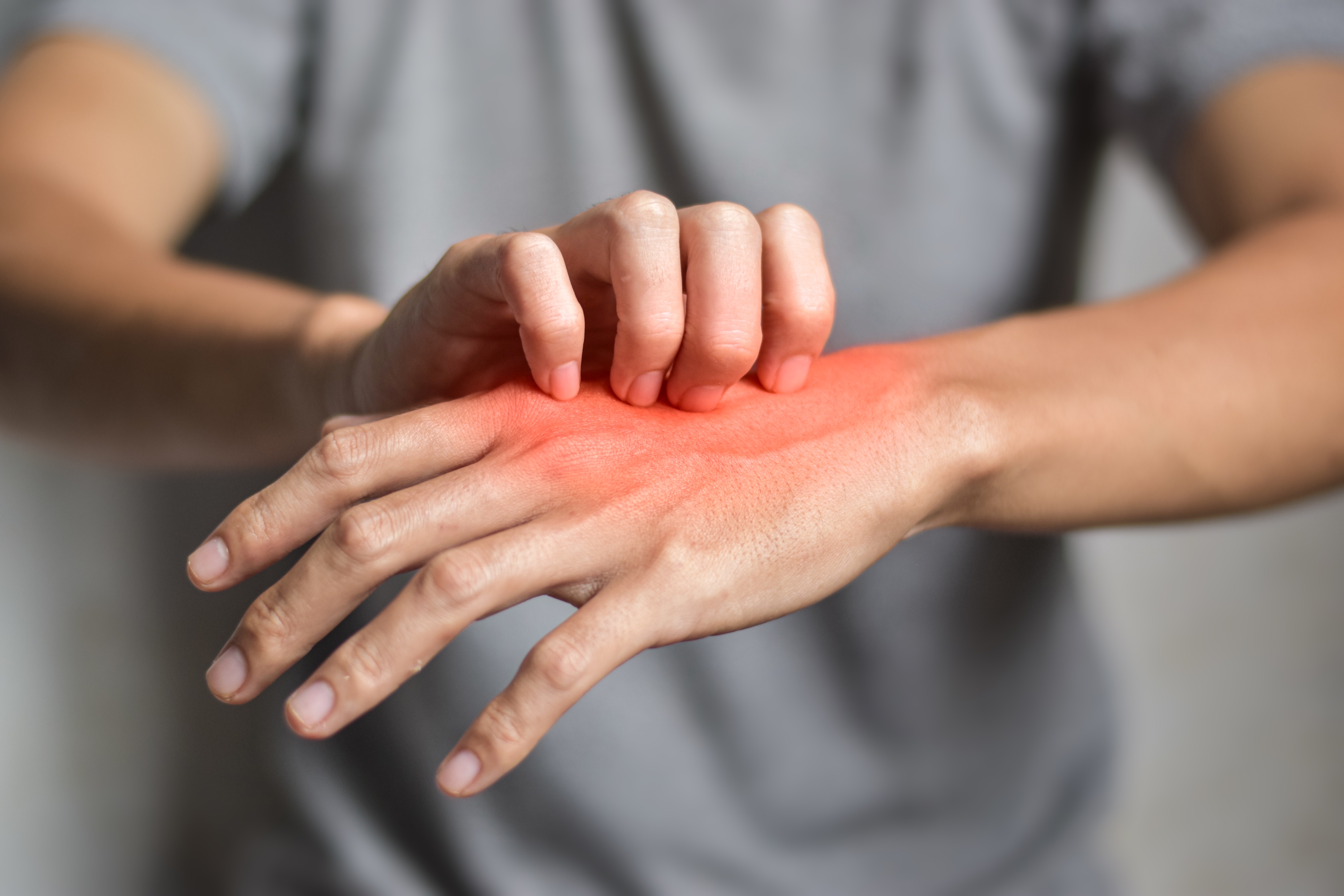
CDC – Scabies – Disease
When a person is infested with scabies mites the first time, symptoms usually do not appear for up to two months (2-6 weeks) after being infested; however, an infested person still can spread scabies during this time even though he/she does not have symptoms.
If a person has had scabies before, symptoms appear much sooner (1-4 days) after exposure. An infested person can transmit scabies, even if they do not have symptoms, until they are successfully treated and the mites and eggs are destroyed.
Common Symptoms
The most common symptoms of scabies, itching and a skin rash, are caused by sensitization (a type of “allergic” reaction) to the proteins and feces of the parasite. Severe itching (pruritus), especially at night, is the earliest and most common symptom of scabies. A pimple-like (papular) itchy (pruritic) “scabies rash” is also common. Itching and rash may affect much of the body or be limited to common sites such as:
- Between the fingers
- Wrist
- Elbow
- Armpit
- Penis
- Nipple
- Waist
- Buttocks
- Shoulder blades
The head, face, neck, palms, and soles often are involved in infants and very young children, but usually not adults and older children.
Tiny burrows sometimes are seen on the skin; these are caused by the female scabies mite tunneling just beneath the surface of the skin. These burrows appear as tiny raised and crooked (serpiginous) grayish-white or skin-colored lines on the skin surface. Because mites are often few in number (only 10-15 mites per person), these burrows may be difficult to find. They are found most often in the webbing between the fingers, in the skin folds on the wrist, elbow, or knee, and on the penis, breast, or shoulder blades.
Possible Complications
The intense itching of scabies leads to scratching that can lead to skin sores. The sores sometimes become infected with bacteria on the skin, such as Staphylococcus aureus or beta-hemolytic streptococci. Sometimes the bacterial skin infection can lead an inflammation of the kidneys called post-streptococcal glomerulonephritis.
Crusted (Norwegian) scabies
Crusted scabies is a severe form of scabies that can affect the elderly, persons who are immunocompromised, or persons who have conditions that prevent them from itching and/or scratching (spinal cord injury, paralysis, loss of sensation, mental debility). Crusted scabies is characterized by vesicles and thick crusts over the skin that can contain many mites. Itching (pruritus) may be absent in crusted scabies because of a patient’s altered immune status or neurological condition. Because they are infested with large numbers of mites (up to 2 million), persons with crusted scabies are very contagious. Persons with crusted scabies may not show the usual signs and symptoms of scabies such as the characteristic rash or itching (pruritus).
Crusted scabies is characterized by vesicles and thick crusts over the skin that can contain many mites. Itching (pruritus) may be absent in crusted scabies because of a patient’s altered immune status or neurological condition. Because they are infested with large numbers of mites (up to 2 million), persons with crusted scabies are very contagious. Persons with crusted scabies may not show the usual signs and symptoms of scabies such as the characteristic rash or itching (pruritus).
Scabies | NHS inform
See all parts of this guide
Hide guide parts
-
1.
About scabies
-
2.
Symptoms of scabies
-
3.
Causes of scabies
-
4.
Diagnosing scabies
-
5.
Treating scabies
-
6.
Complications of scabies
About scabies
Scabies is a contagious skin condition caused by tiny mites that burrow into the skin.
The main symptom of scabies is intense itching that’s worse at night. It also causes a skin rash on areas where the mites have burrowed.
Read more about the symptoms of scabies.
Scabies mites
Scabies mites are called Sarcoptes scabiei. They feed using their mouths and front legs to burrow into the outer layer of skin (epidermis), where they lay eggs.
After 3 to 4 days, the baby mites (larvae) hatch and move to the surface of the skin, where they mature into adults.
Scabies like warm places, such as skin folds, between the fingers, under fingernails, or around the buttock or breast creases. They can also hide under watch straps, bracelets or rings.
Read more about the life cycle of the scabies mite.
How scabies is spread
Scabies is usually spread through prolonged periods of skin-to-skin contact with an infected person, or through sexual contact.
It’s also possible – but rare – for scabies to be passed on by sharing clothing, towels and bedding with someone who’s infected.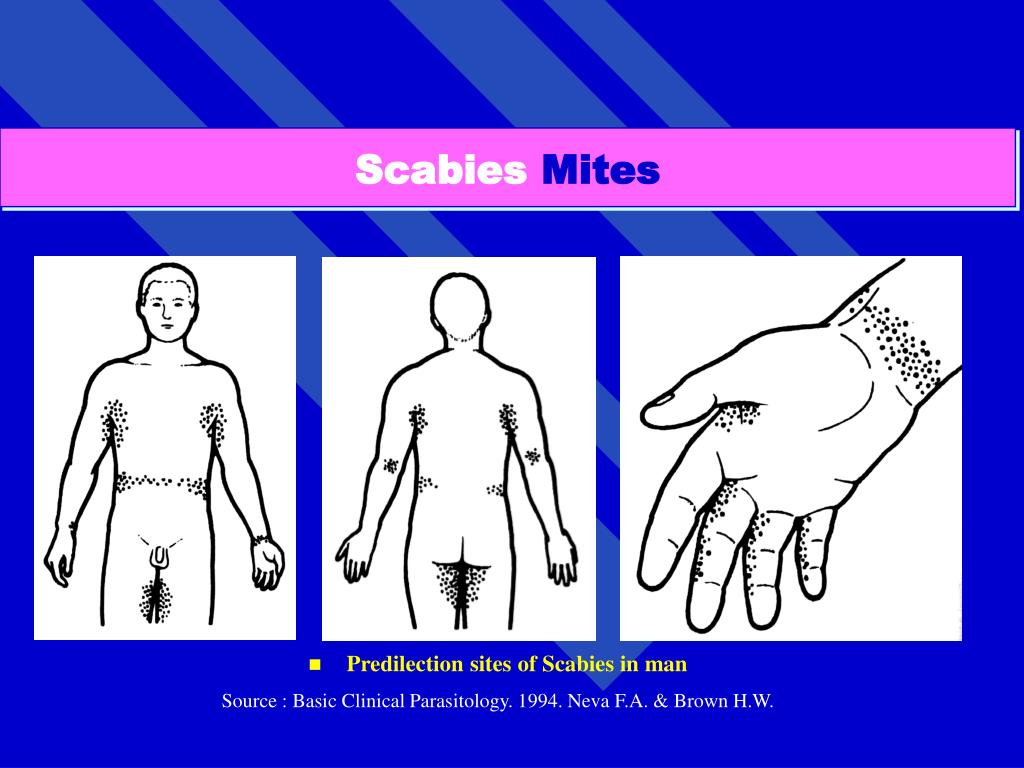
It can take up to 8 weeks for the symptoms of scabies to appear after the initial infection. This is known as the incubation period.
Read more about the causes of scabies.
Scabies outbreaks
Scabies is widespread in densely populated areas with limited access to medical care, and is most common in the following tropical and subtropical areas:
- Africa
- Central and South America
- northern and central Australia
- Caribbean Islands
- India
- southeast Asia
In developed countries, scabies outbreaks can sometimes occur in places where there are lots of people, such as schools, nurseries and care homes.
In the UK, most outbreaks of scabies occur in the winter. This may be because people tend to spend more time indoors and closer to each other at this time of year.
It’s difficult to know exactly how many cases of scabies there are in the UK. This is because many people don’t visit their GP and treat the condition with non-prescription medicines.
Treating scabies
Visit your GP if you think you have scabies. It’s not usually a serious condition, but it does need to be treated.
The 2 most widely used treatments for scabies are permethrin cream and malathion lotion (brand name Derbac M). Both medications contain insecticides that kill the scabies mite.
Permethrin 5% cream is usually recommended as the first treatment. Malathion 0.5% lotion is used if permethrin is ineffective.
If your partner has been diagnosed with genital scabies, to avoid reinfection you should visit your nearest sexual health clinic so you can be checked and, if necessary, treated.
Avoid having sex and other forms of close bodily contact until both you and your partner have completed the full course of treatment.
Read more about diagnosing scabies and treating scabies.
Complications of scabies
Scabies can sometimes lead to a secondary skin infection if your skin becomes irritated and inflamed through excessive itching.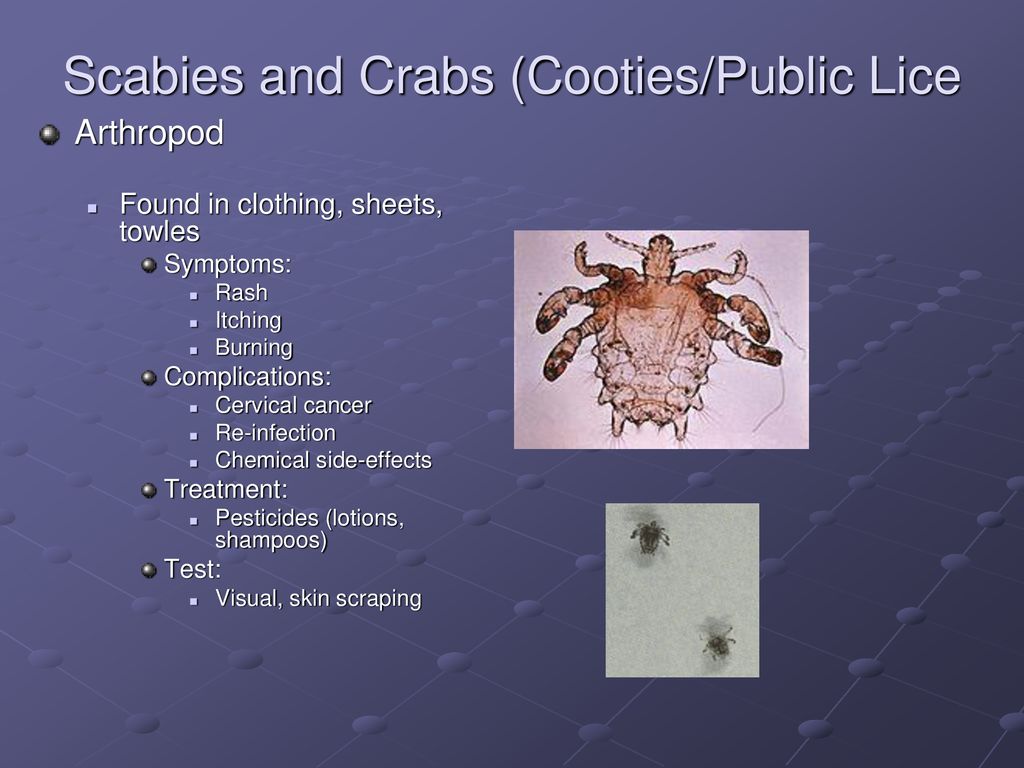
Crusted scabies is a rare but more severe form of scabies, where a large number of mites are in the skin. This can develop in older people and those with a lowered immunity.
Read more about complications of scabies.
Symptoms of scabies
The main symptoms of scabies are intense itching and a rash in areas of the body where the mites have burrowed.
The itching is often worse at night, when your skin is warmer. It may take 4 to 6 weeks before the itching starts because this is how long it takes for the body to react to mite droppings.
Symptoms will start within 1 to 2 days if you’ve had a scabies infection in the past. This is because your immune system will have learned to respond to a scabies infection.
What does a scabies rash look like?
The scabies rash consists of tiny red spots. Scratching the rash may cause crusty sores to develop.
Burrow marks can be found anywhere on the body. They’re short (1cm or less), wavy, silver-coloured lines on the skin, with a black dot at one end that can be seen with a magnifying glass.
Scabies cause burrow marks of short, wavy and silver-coloured lines.
Source: https://dermnetnz.org/
A scabies rash often appears on the palms of the hands.
Source: https://dermnetnz.org/
Where does a scabies rash develop?
In adults, burrow marks often appear in the following areas:
- the folds of skin between fingers and toes
- the palms of the hands
- the soles and sides of the feet
- the wrists
- the elbows
- around the nipples (in women)
- around the genital area (in men)
The rash usually affects the whole body, apart from the head. The following areas can be particularly affected:
- the underarm area
- around the waist
- the inside of the elbow
- the lower buttocks
- the lower legs
- the soles of the feet
- the knees
- the shoulder blades
- the female genital area
- the groin
- around the ankles
Elderly people, young children and those with a low immune system (immunocompromised) may also develop a rash on their head and neck.
Men usually have 1 or more very itchy, lumpy, 3 to 10mm spots on the skin of the genitals (on the penis and scrotum).
In infants and young children, burrow marks tend to appear in different places on their body, including on the:
- face
- head
- neck
- scalp
- palms of the hands
- soles of the feet
Scabies mites leave small red blotches and silver-coloured lines on the skin. These marks are caused by the mites burrowing into the skin.
In infants with scabies, blisters and pustules (small blisters that contain pus) may develop on the soles of the feet and palms of the hands.
Causes of scabies
Scabies is a skin condition caused by the parasite Sarcoptes scabiei.
The intense itching associated with scabies is thought to be caused by the immune system reacting to the mites and their saliva, eggs and faeces.
The scabies mite life cycle
A scabies infestation starts when a female mite burrows into your skin.
Male mites move between different burrow sites looking to mate. After mating, the male mite dies and the female begins to lay eggs, which hatch around 3 to 4 days later.
After hatching, the young mites move to the surface of the skin, where they mature into adults after 10 to 15 days. Male mites stay on the surface of the skin, while female mites burrow back into the skin to create a new burrow. The life cycle is then repeated.
Without effective treatment, the life cycle of the scabies mite can continue indefinitely. Scabies mites are resistant to soap and hot water and can’t be scrubbed out of the skin.
How scabies is spread
Scabies mites can’t fly or jump, which means they can only move from one human body to another if 2 people have direct and prolonged physical contact.
For example, scabies mites can be transmitted by:
- holding hands with an infected person for a prolonged period of time
- having sex with an infected person
- sharing clothing, towels and bedding with an infected person (although this is rare)
It’s unlikely that scabies will be transmitted through brief physical contact, such as shaking hands or hugging.
Scabies mites can survive outside the human body for 24 to 36 hours, making infection by coming into contact with contaminated clothes, towels or bed linen a possibility. However, it’s rare for someone to be infected in this way.
Scabies infestations can spread quickly because people are usually unaware they have the condition until 2 to 3 weeks after the initial infection.
There’s an increased risk of catching scabies in confined environments, such as schools and nursing homes, where people are in close proximity to one another.
Diagnosing scabies
Your GP should be able to diagnose scabies from the appearance of your skin, and by looking for the burrow marks of the Sarcoptes scabiei mite.
However, as scabies is spread very easily, it’s often possible to make a confident diagnosis if more than one family member has the same symptoms.
Your GP will also want to rule out other skin conditions that may be causing your symptoms, such as eczema or impetigo (a highly contagious bacterial skin infection).
Read more about the symptoms of scabies.
Ink test
The burrows of scabies mites can be identified by using an ink test. Ink is rubbed around an area of itchy skin before being wiped off with an alcohol pad.
If scabies burrows are present, some of the ink will remain and will have tracked into the burrows, showing up as a dark line.
To confirm the diagnosis, a skin sample may be gently scraped from the affected area so it can be examined under a microscope for evidence of scabies mites, their eggs and faeces (poo).
Where to get help with scabies
Visit your GP if you think you have scabies. If you think you have genital scabies or your partner has been diagnosed with it, visit your nearest sexual health clinic, where you’ll be examined and, if necessary, treated.
If you decide to treat scabies yourself, you’ll need to have a full sexual health check to make sure you don’t have any sexually transmitted infections (STIs).
To prevent reinfection, it’s important that all members of your household are treated, as well as any sexual partners you’ve had over the last 6 weeks (in the case of genital scabies). If you’ve had genital scabies in the past, anyone you’ve had sex with in the previous 48 hours will need to be treated.
If you’ve had genital scabies in the past, anyone you’ve had sex with in the previous 48 hours will need to be treated.
If you’re embarrassed about contacting previous sexual partners, your GP surgery or local sexual health clinic may be able to inform them that they’ve been exposed to scabies on your behalf without disclosing your identity.
Sexual health clinics
Some sexual health clinics operate on a walk-in basis. Others work by appointment only. It’s therefore a good idea to call first.
When you attend a clinic, you’ll be asked for your name, date of birth and contact details. These details will be treated confidentially and won’t be passed on to your GP without your agreement.
You’ll also be asked about your sexual history, including:
- when you last had sex
- whether you used condoms
- whether you’ve had an STI in the past
- whether you’re taking any medication
If you’re attending a clinic for scabies, you may also be offered tests for STIs.
Treating scabies
See your GP immediately if you have scabies and you haven’t had a previous infection. Delaying treatment places other people at risk.
As other more serious skin conditions can sometimes cause similar symptoms to the symptoms of scabies, your GP will need to rule these out.
If you have scabies, your partner will also need to be treated regardless of whether or not they have any symptoms. This is because it’s highly likely that scabies will have been transmitted through close bodily contact, such as during sex.
To reduce the risk of reinfection, avoid having sex and other forms of prolonged close bodily contact, such as holding hands, until both you and your partner have completed the full course of treatment.
If you’ve been diagnosed with scabies, you may be advised to visit your nearest sexual health clinic to be checked and, if necessary, treated for other sexually transmitted infections (STIs).
Lotions and creams
Lotions and creams are commonly used to treat scabies. Your GP, pharmacist or nurse will be able to advise you about which treatment to use.
Your GP, pharmacist or nurse will be able to advise you about which treatment to use.
Applying the cream or lotion
To prevent reinfection, all members of your household and any close contacts, including recent sexual partners, should be treated at the same time as you, even if they don’t have any symptoms.
The cream or lotion should be applied to the skin of all of your body, except your head. Before you apply it, make sure your skin is cool and dry. Don’t apply it after having a hot bath.
If you apply it when your body is hot, it will quickly be absorbed into your skin and won’t remain on the area where the scabies burrows are.
When using a cream or lotion to treat scabies, you should also:
- read the patient leaflet that comes with the cream or lotion for details of where to apply it – some products need to be applied to the whole body, including the scalp and face, whereas others must only be applied from the neck down
- pay particular attention to difficult-to-reach areas, like your back, the soles of your feet, in between your fingers and toes, under fingernails, and on your genitals
- use a cotton bud or old toothbrush to apply the treatment under fingernails and toenails – put the cotton bud or toothbrush in a bag and throw it away afterwards
- leave the treatment on your skin for 8 to 24 hours (depending on the preparation used) before washing it off thoroughly – follow the manufacturer’s instructions regarding how long to leave the cream or lotion on for
- reapply the cream or lotion immediately to any areas of skin that are washed during the period of application
- wash bed linen, nightwear and towels after the first application
- repeat the treatment process 7 days after the first application to ensure it’s successful – the second application will ensure any mites hatched from existing eggs are killed
It can take a month after treatment for the general itching to subside completely, and longer for the lumpy genital lesions to resolve. Your GP may recommend repeating the treatment or they may prescribe a different lotion.
Your GP may recommend repeating the treatment or they may prescribe a different lotion.
Non-urgent advice:
Speak to your GP if:
- the itching hasn’t improved after 2 weeks of treatment and you notice new burrows on your skin
- you experience any persistent side effects
Managing a scabies infection
On the day you first apply the cream or lotion, you should wash all bed linen, nightwear and towels at a temperature above 50C (122F).
If you’re unable to wash certain items, place them in a plastic bag for at least 72 hours. After this time, the scabies mites will have died.
In cases of crusted scabies, you should clean the floors in your house and thoroughly vacuum your carpets and furniture, including the armchairs and sofa.
If you’ve been diagnosed with scabies, avoid close and prolonged physical contact with others until you’ve applied the cream or lotion. You should also avoid close contact with other members of your household until their treatment has been completed.
Children and adults can return to school or work after the first treatment has been completed.
Treating the itch
Your GP should be able to prescribe treatments, such as a mild steroid cream, to reduce the itchiness. Menthol cream or gel, available from pharmacies without a prescription, may also help relieve itchy skin.
Oral sedative antihistamines are also available from your local pharmacy and can be used to control itching and help you get a better night’s sleep.
As this type of antihistamine can cause drowsiness, you should avoid driving or operating heavy machinery if you’re affected in this way.
Non-sedating antihistamines don’t help relieve the itching of scabies. Check with your GP or pharmacist if you’re unsure.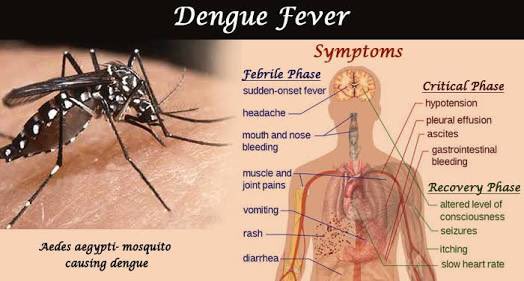
You may continue to experience itchiness for a couple of weeks after your treatment has been completed. This is because your immune system will still be reacting to the presence of dead mites and their droppings.
Visit your GP if you’re still experiencing itchiness 6 weeks after completing your treatment.
Complications of scabies
A secondary infection and crusted scabies are 2 possible complications of scabies.
Secondary infection
Repeatedly scratching itchy skin caused by scabies may break the skin’s surface. This will make you more vulnerable to developing a bacterial skin infection, such as impetigo.
Antibiotics may be recommended to control a secondary infection.
Scabies has been known to make some pre-existing skin conditions, such as eczema, worse. However, other skin conditions should settle down after the scabies infection has been successfully treated.
Crusted scabies
Crusted scabies, also known as Norwegian scabies, is a more severe form of scabies.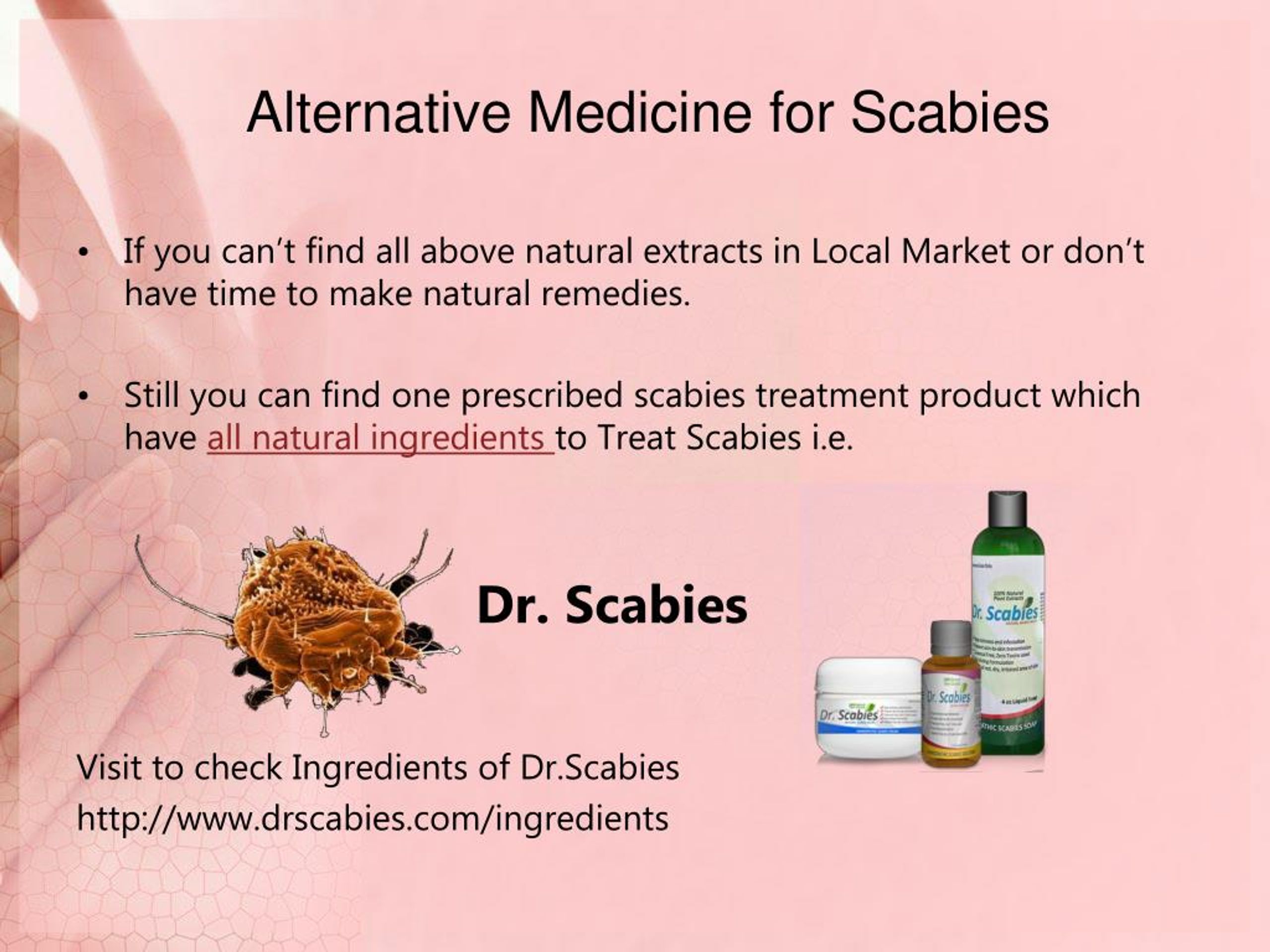 This means thousands or even millions of scabies mites are present.
This means thousands or even millions of scabies mites are present.
Normal scabies can develop into crusted scabies after a skin reaction. The condition affects all parts of the body, including your head, neck, nails and scalp. However, unlike normal scabies, the rash associated with crusted scabies usually doesn’t itch.
In crusted scabies, the increase in the number of mites causes thick, warty crusts to develop on the skin. It’s often mistaken for psoriasis (a skin condition that causes red, flaky, crusty patches of skin covered with silvery scales).
Crusted scabies affects people with a weakened immune system (the body’s natural defence against infection and illness). This includes:
- the very young
- people with brain disorders (neurological disorders, such as Parkinson’s disease)
- people with Down’s syndrome
- pregnant women
- elderly people
- people with a condition that affects their immune system, such as HIV or AIDs
- people who are taking steroids to treat other medical conditions
- people who are having chemotherapy treatment
Research has found a healthy immune system appears to interrupt the reproductive cycle of the scabies mite. For example, most people with scabies will only have 5 to 15 mites on their body at any one time.
For example, most people with scabies will only have 5 to 15 mites on their body at any one time.
However, if you have a weakened immune system, the number of scabies mites can increase significantly. People with crusted scabies can have thousands or millions of scabies mites on their body at any one time.
Because of the high number of scabies mites, crusted scabies is highly contagious. Even minimal physical contact with a person with crusted scabies, or with their bed linen or clothes, can lead to infection.
However, contact with someone with crusted scabies will only lead to the normal type of scabies in people with a healthy immune system.
Crusted scabies can be treated using insecticide creams or a medicine called ivermectin, which is taken by swallowing a tablet. Ivermectin kills the mites by stopping their nervous system working.
Scabies: symptoms, treatment and prevention of the disease
May 8, 2019
Likbez
Health
Scabies mites are waiting for you at home, at work and in public places.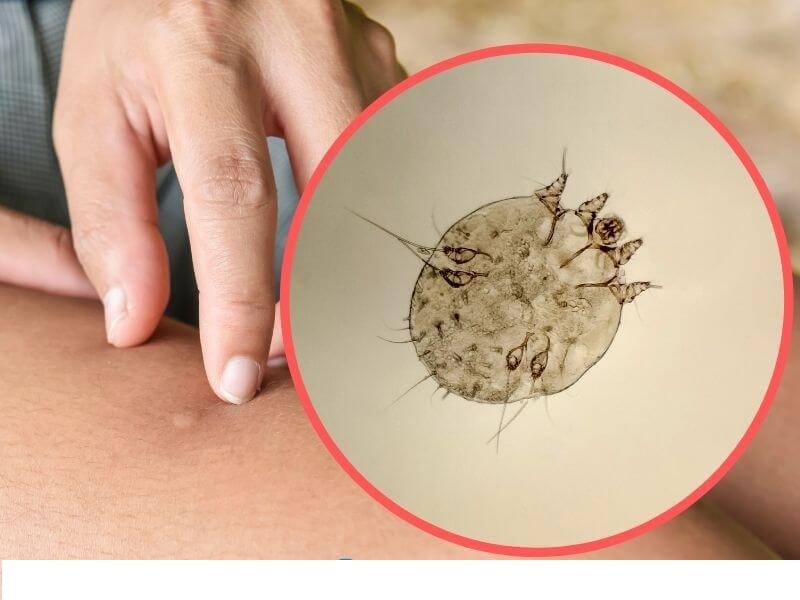
What is scabies
Scabies is a contagious skin disease caused by the scabies mite. The microscopic parasite burrows into the top layer of the skin and lays eggs. The body reacts to this with an allergy – a rash and itching.
When the eggs laid mature, new mites hatch from them. They spread throughout the body of the sick person, and are also transmitted to other people.
On average, mites live on the skin for a couple of months. During this time, the patient manages to infect those who come into contact with him every day: family, friends, classmates, colleagues.
What are the symptoms of scabies
Most often, scabies affects the area between the fingers, bends of the knees and elbows, inside wrists, armpits, feet, chest, buttocks, waist, pubis. In infants, the skin under the hair on the head, neck, shoulders, and palms may also be affected.
1 / 0
Rash with scabies / dermline.ru
2 / 0
Rash and sores on the skin with scabies / dermline.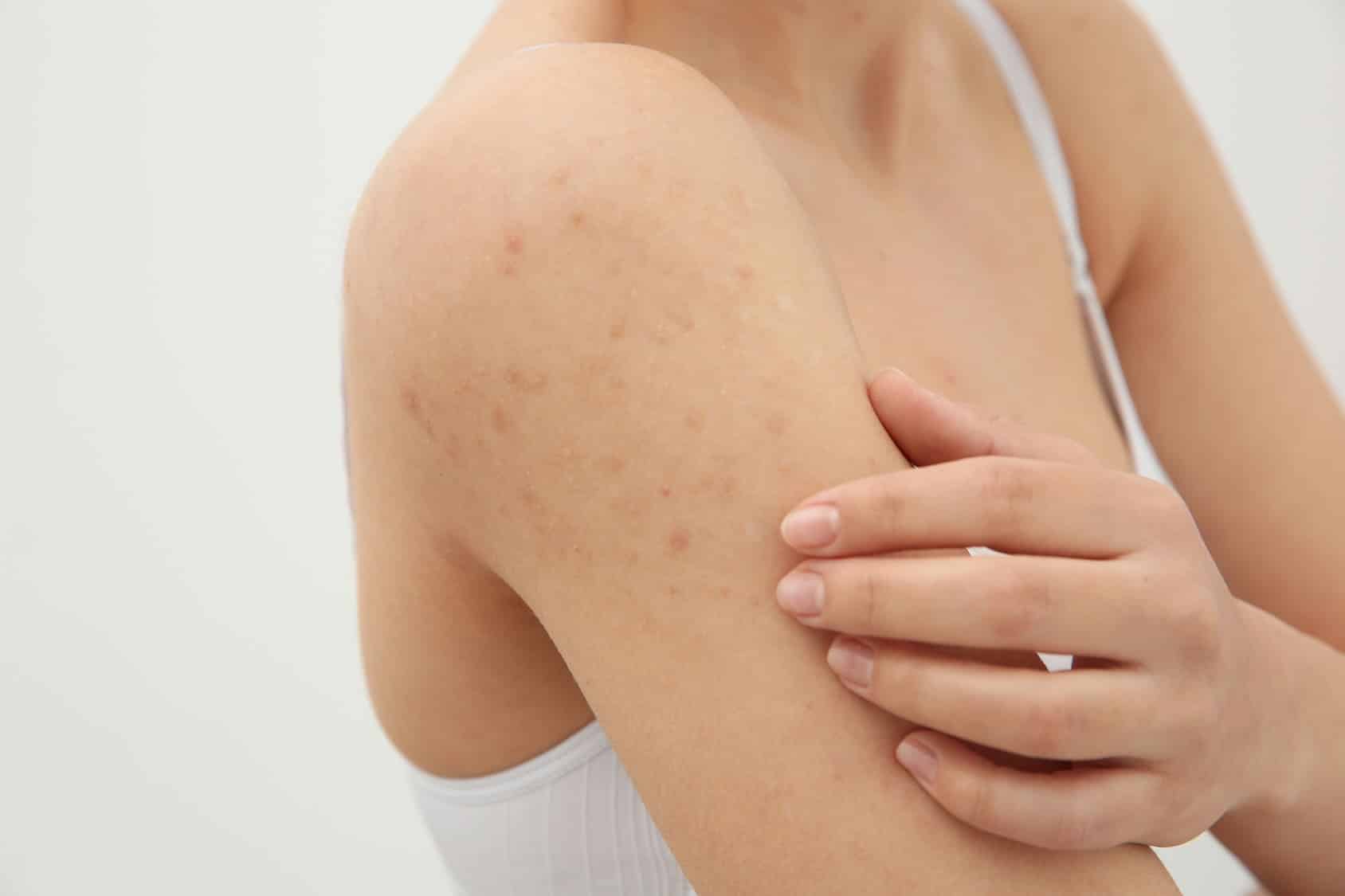 ru
ru
The symptoms of scabies are very inconvenient and hard to miss:
- Itching. It is detected first and increases at night to such an extent that it interferes with sleep.
- Rash. Tiny bumps resemble pimples or bites. They form when a tick dives under the skin.
- Ulcers. Due to severe itching, a person itches and leaves wounds on the body. Ulcers are dangerous because when dirt and germs get into them, an infection can develop.
- Peel. This is already a sign of severe scabies – Norwegian, first described in Norway in the middle of the 19th century. With ordinary scabies, there are an average of 15-20 ticks on the patient’s body, with Norwegian scabies, their number increases to several hundred or even thousands. And they damage the skin so that crusts form.
How scabies is transmitted
Very easy and fast. Infection occurs mainly through physical contact: during hugs, kisses, sex, handshakes and even fleeting accidental touches on public transport.
However, the tick may also be on the patient’s clothing or other belongings. Without the nutrition provided by the host, the parasite lives for 48–72 hours.
Who can get scabies
The most common cases of scabies are:
- Schoolchildren and kindergarteners: they come into contact with a lot of people every day.
- Their parents and other family members.
- People who often change sexual partners.
- Employees and visitors to public institutions – schools and kindergartens, universities, nursing homes, sports locker rooms, rehabilitation centers, hospitals and prisons.
- People with weakened immune systems, including those with HIV or AIDS and those undergoing chemotherapy.
- Older people: their immunity is less resistant to disease.
If you do not belong to any of the items on the list, this does not mean that you will not get infected. According to WHO, scabies is one of the most common skin diseases.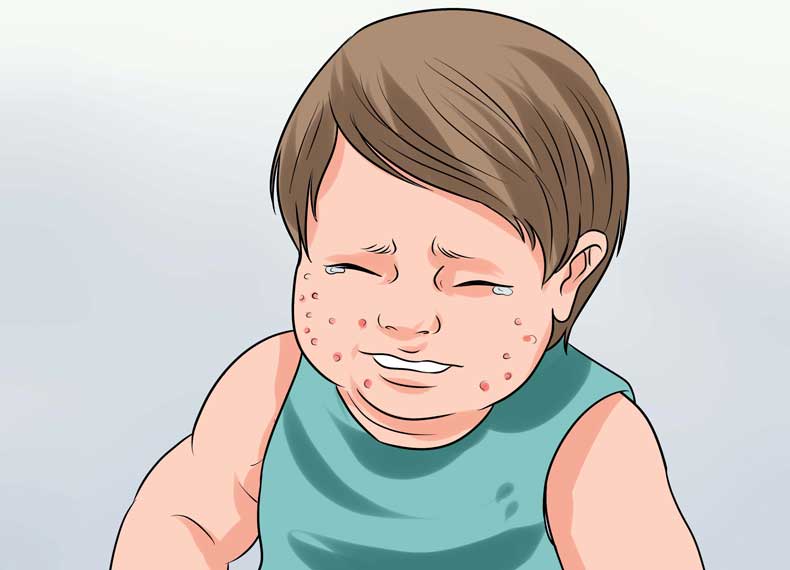 At any given time, it affects about 200 million people.
At any given time, it affects about 200 million people.
The situation is further complicated by the fact that scabies has a long incubation period. After infection, a person may be unaware of the disease for two whole months and at the same time be its carrier.
How not to get scabies
The surest way is not to touch the sick and not to touch their belongings. But this is not possible if the infected person lives with you or you simply do not know that the person has scabies.
Rules for those who have a sick person at home
A rash of unknown origin may be scabies. Therefore, as soon as you notice it in a loved one, immediately send him to the doctor to find out the diagnosis and start treatment.
If it’s scabies, try to be safe:
- Wash the patient’s clothes and bedding regularly. It is advisable to do this every day. The water temperature must be at least 50 °C. Add powder or bleach to the water, just rinse things thoroughly after that so as not to cause irritation.
 Let the clothes dry naturally or on the warmest setting in the washing machine. At the end, carefully iron everything with an iron.
Let the clothes dry naturally or on the warmest setting in the washing machine. At the end, carefully iron everything with an iron. - Vacuum and mop the floor in the house. Throw away the bag of the vacuum cleaner in which the dust remains. This must be done at the beginning of treatment and at the end.
- Spray all you can with permethrin disinfectant spray. Floor, carpets, furniture, appliances, gadgets, decorations. Do this at the beginning of treatment, and then when the doctor confirms that the patient has recovered. This will help prevent re-infection.
- Put everything that cannot be washed or sprayed into an airtight bag. For example, jewelry, books and toys will have to be sent in a bag for a week. During this time, the ticks will die without food and things can again be used.
- Give the patient a separate towel. No one but him should wipe himself with it.
- Wash your hands with soap and water after each contact with a sick person. Wash the area between your fingers especially carefully and don’t forget your nails – these are places where ticks can lurk.

If you follow these rules and the doctor’s instructions, the disease will not spread to the whole family.
Daily Prevention for All
These simple tips will help reduce your risk of scabies:
- Wash your hands after being outdoors. Even if you have been out of the house for a while and it seems that they are clean. At the very least, you’ve touched a doorknob, an intercom button, or an elevator. In front of you, anyone could touch them.
- Wet your home regularly. Disinfect floors and furniture at least once a week with hot water and chlorine.
- Do not give anyone personal items. Comb, clothes, towel, toothbrush must be your own.
- Do not dry your hands with a reusable towel in public places. Ticks are very often transmitted through towels.
- Minimize the number of sexual partners. Due to prolonged contact with someone else’s skin, the likelihood of infection is very high.
How to treat scabies
If you notice symptoms of scabies in yourself or someone you have been in contact with, contact your doctor immediately.
The most commonly prescribed ointments and lotions for the treatment of scabies include permethrin, lindane, benzyl benzoate, crotamiton, or sulfur. These chemicals kill scabies mites.
In addition, to reduce itching, you can:
- Bathe in cool water or apply a cold compress to the affected areas of the body.
- Apply over-the-counter soothing body lotion. For example, with aloe vera, tea tree oil or calamine.
- Take antihistamines. You need to find out the names and dosage from your doctor.
Do not self-medicate. Otherwise, you risk earning a complication – a secondary infection of the skin, from which you will have to get rid of antibiotics.
Read also 🤗🚿👀
- What is lichen and what to do to never encounter it
- Why does the skin on the arms, legs and other parts of the body peel off
- What to do if you are bitten by insects
- Where do back pimples come from and how to get rid of them
- Why does the skin on the face peel off and what to do about it
Scabies in children – symptoms and treatment
We treat children according to the principles of evidence-based medicine: we choose only those diagnostic and treatment methods that have proven their effectiveness. We will never prescribe unnecessary examinations and medicines!
We will never prescribe unnecessary examinations and medicines!
Make an appointment via WhatsApp
Video
Prices
Doctors
The first children’s clinic of evidence-based medicine in Moscow
No unnecessary examinations and drugs! We will prescribe only what has proven effective and will help your child.
Treatment according to world standards
We treat children with the same quality as in the best medical centers in the world.
The best team of doctors in Fantasy!
Pediatricians and subspecialists Fantasy – highly experienced doctors, members of professional societies. Doctors constantly improve their qualifications, undergo internships abroad.
Ultimate safety of treatment
We have made children’s medicine safe! All our staff work according to the strictest international standards JCI
We have fun, like visiting best friends
Game room, cheerful animator, gifts after the reception.


 Let the clothes dry naturally or on the warmest setting in the washing machine. At the end, carefully iron everything with an iron.
Let the clothes dry naturally or on the warmest setting in the washing machine. At the end, carefully iron everything with an iron.